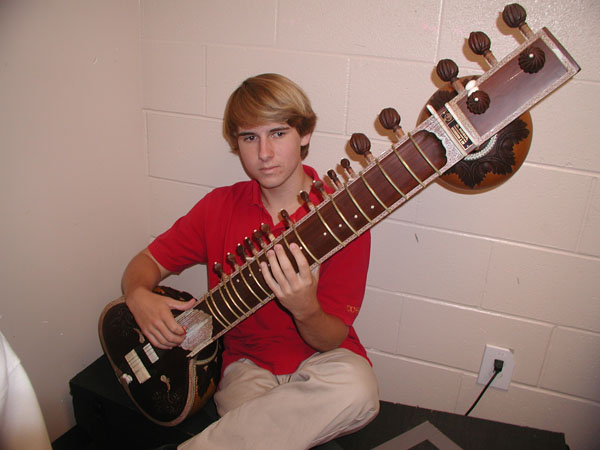The exotic, rich melodies of the Indian traditional culture have made their way to the Cathedral campus through one senior musician, Steven Kennedy, who plays, among a variety of other instruments, the sitar.
Steven has already played the sitar at many school events so far this year, particularly at the Red Mass in the very beginning of the year, which introduced a very new, exotic style of song. Steven, who is in both Band and Campus Ministry, began playing the sitar last year in his junior year, teaching himself how to play this wondrous instrument by reading books and practicing.
Though this unique instrument only looks like a guitar, it is much different from its common look-a-like; for one thing there are different types of sitars to accommodate to different skill levels.
“It’s far more complicated,” said Steven. “It has triple the number of strings.”
The key difference, Steven said, were the sounds. The Toombas, or sound resonators, along with the steel and bronze strings and dimensions of the instrument, produce softer sounds than the guitar. Also, the plectrums used are different. While the guitar uses a pick, a sitar uses the traditional mizrab. While playing the sitar, one only uses their index finger to use the mizrab, but uses his or her index and middle fingers to fret the sitar.
Steven’s favorite thing about playing the sitar is, besides exploring new genres and worlds of music, the culture behind it and the fundamentals of the ragas. In India, ragas, or performances, are the traditional songs played on all Indian instruments. They are named after the scale they are in, so right away the listener knows what to listen for. There is strict fingering involved when playing the sitar to go along with an even stricter structure to the ragas. Different ragas exist for different times of the day, different seasons, or even different feelings.
“Everything you play comes from you. Every raga played, even though there is a set structure for them, is based off improvisation and emotion. In India they believe each individual note has a quality, ranking, and purpose in the song,” he said.
Though these songs are a sure difficulty to master, Steven is in the process of learning quite of few of them. However, holding the instrument itself is another thing to master in itself.
“The sitar is definitely not for beginners,” said Steven. “The traditional position of playing the sitar is challenging. You’re placing pressure on the thigh of your left leg and as time passes, the weight of the instrument really tires you out. You really have to be patient and take your time with this instrument.”






















































Ann Gladys • Nov 1, 2010 at 4:21 PM
How wonderful to see attention to cultural diversity in the form of music and, more importantly, to see it come from within the CC student body! Nicely written article, Katie and way to go, Steven; your musical talent is obvious in your personal drive to learn instruments on your own! I’m impressed!
Ann Gladys,
Doctoral Student
Pepperdine University
anonymousperson1 • Oct 29, 2010 at 7:36 PM
I love how we have all these different insruments at school! Ii really shows the school’s diversity! Nice article~ 🙂